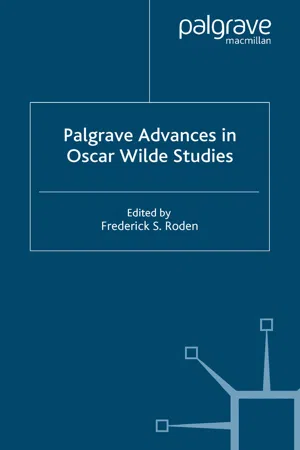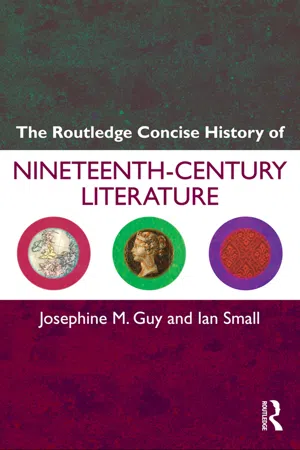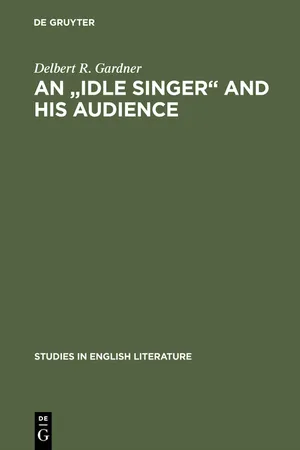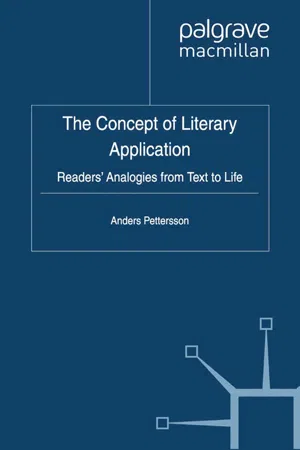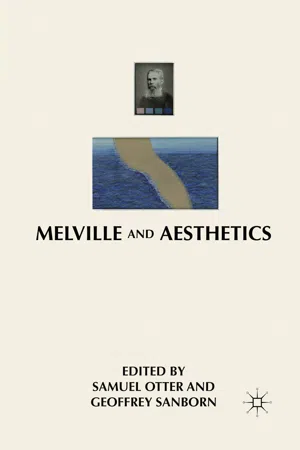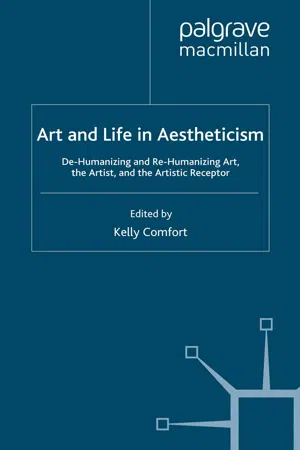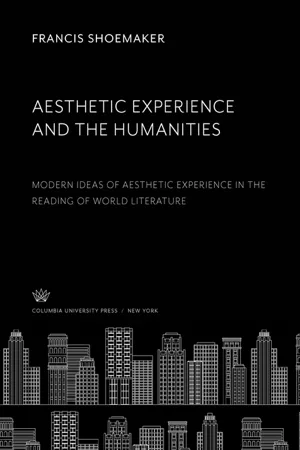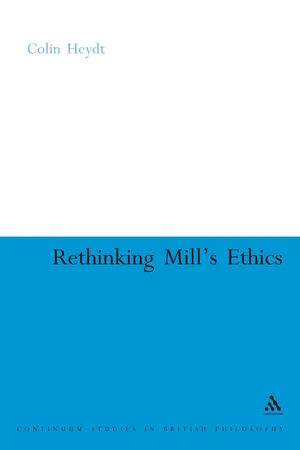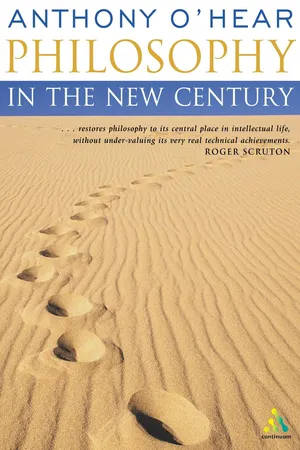Literature
Aestheticism
Aestheticism is an artistic movement that emerged in the late 19th century, emphasizing the pursuit of beauty and the aesthetic experience in literature and other art forms. It prioritizes the sensory and emotional aspects of art over moral or social messages, often celebrating art for art's sake. Aestheticism is characterized by its focus on decadence, refined style, and the cultivation of individual sensibility.
Written by Perlego with AI-assistance
Related key terms
1 of 5
11 Key excerpts on "Aestheticism"
- eBook - PDF
- Frederick S. Roden(Author)
- 2004(Publication Date)
- Palgrave Macmillan(Publisher)
Johnson states in his classic account, is that “the enjoyment of beauty can by itself give value and meaning to life.” 10 Aes- theticism manifested itself in multiple aspects of late nineteenth-century life. In its more rarified, ideal form, Aestheticism is the concern with developing a heightened awareness and responsiveness to life and art. In its popular, material forms, Aestheticism is bound with the idea of making conscious, individual consumer choices in homage to the beautiful. Though John Ruskin is largely credited with setting the tone for Aestheticism in his call for beautifying everyday life, Pre-Raphaelite artists, including Dante Gabriel Rossetti, Edward Burne-Jones, and Algernon Charles Swinburne, among others, exemplified it in expressing a sensuous yearning for ideal beauty. Aestheticism’s most complete articulation is traditionally found in the writings of Pater and Wilde in the 1870s, 1880s and 1890s. 11 Roughly, Aestheticism tends to place a high value on the following: artistic form, a heightened consciousness that is alert to both physical and spiritual experience (spirituality often deriving from physicality), art’s ability to create sympathy, art’s ability to recreate the Aestheticism and aesthetic theory 99 individual beholder through a process of conscious self-transcendence (this may also be called “self-culture”), and the individual’s need for self- expression in spite of, or at the expense of, social norms. In nineteenth-century England, a large and socially fragmented reading public made the eighteenth-century ideal of a “rational” public sphere seemingly impossible. Wilde’s dependence on, and yet disdain for, the “fatal development of the habit of reading amongst the middle and lower classes of” England demonstrates a new relationship between artist and audience in which the artist only knows the audience as a consuming, capricious mass. - Josephine Guy, Ian Small(Authors)
- 2010(Publication Date)
- Routledge(Publisher)
Modern critics, however, have viewed the Aesthetic Movement’s association of literary and sexual freedom more positively. They have, for example, seen continuities between Aestheticism’s concern with style and the formal experimentation found in Modernist writing. (In the semi-autobiographical Portrait of the Artist as a Young Man (1914–15) by James Joyce Stephen Dedalus’s intellectual and sexual emancipation from the constraints of the Catholic church and life in Dublin are partly troped through a Paterian-sounding endorsement of art, understood as ‘the human disposition of sensible or intelligible matter for an esthetic end’.) They have also elaborated more subtle and complex understandings of the sexual politics of Aestheticism (Dellamora 1990; Denisoff 2006). Moreover, this recognition of Aestheticism as a literary or cultural vanguard (rather than, as its contemporary detractors saw it, simply a fad) has in recent years given shape to a question, most neatly posed by Talia Schaffer: ‘Who were aesthetic writers, and what texts count as aesthetic?’ (Schaffer 2000: 1). As we noted earlier, when literary and cultural historians first began to investigate the Aesthetic Movement in the late 1960s and early 1970s the ‘exponents’ of Aestheticism, as R. V. Johnson had termed them, were all male (Johnson 1969). By contrast, feminist critics like Schaffer have sought to extend the label Aesthetic to a number of late nineteenth-century women writers, whom she terms the ‘forgotten female aesthetes’. To this end, Schaffer has argued for a much ‘looser’ definition of Aestheticism, in which ‘love of children and nature’ and the ‘employment of epigrams and archaisms for the purpose of camouflaging forbidden topics’ become sufficient conditions to group with the familiar Wilde and Pater figures such as Alice Meynell (1847–1922), Rosamund Marriott Watson (who wrote under the pseudonym Graham Thomson, 1860–1911) and E- eBook - PDF
- Kerry Powell, Peter Raby(Authors)
- 2013(Publication Date)
- Cambridge University Press(Publisher)
The aesthetic movement as a trend in British literature, fine arts, architecture, textiles and design usually dates itself from the 1860s and extends through the first decade of the twentieth century, though its influence can be easily observed in various forms of modernism and postmodernism. Some of its defining characteristics in literature are a 150 preoccupation with beauty and refinement of taste in all aspects of art and life, a self-conscious foregrounding of style as a theme, an often languorous preference for contemplation over action, a resistance to moral or political limitations on aesthetic judgement, a valorization of art and artifice even in its abundant references to nature and organic forms, an academic and nostalgic engagement with distinguished aesthetic traditions of the past (especially classical Athens, medieval England and the Renaissance), an Orientalist exoticism (especially by way of the Arabian Nights and Islamic and Japanese decorative arts), a tendency to gender ambiguity and erotic transgressiveness, and a resistance to the vulgarity of a modern commer- cialism and bourgeois taste that it was, nevertheless, sometimes adept at exploiting. In a British and American context, the term has been used to describe phenomena as different as the poetry of A. C. Swinburne and D. G. Rossetti, the prose style of Walter Pater, tapestries and wallpaper by William Morris, paintings by Edward Burne-Jones and J. M. Whistler, drawings and illustrations by Aubrey Beardsley and Charles Ricketts, and furniture by Edward Godwin and Louis Comfort Tiffany. Wilde was familiar with all of the above, and he came to typify what was most challenging and most easily parodied in the literature and dandyism of the movement. - eBook - PDF
An "Idle Singer" and his audience
A study of William Morris's poetic reputation in England, 1858–1900
- Delbert R. Gardner(Author)
- 2015(Publication Date)
- De Gruyter Mouton(Publisher)
B. Yeats, and Arthur Symons. The pre-eminent distinguishing feature of Aestheticism was a belief in the autonomy of art—Art for Art's Sake. It was a categorical denial of the right claimed by Victorian society to make art the handmaiden of middle-class ideals of conduct, politics, and religion. Other ideas, evolved from this basic concept, were also embraced by aesthetic writers, especially those in the final phase, whom I shall call the Aesthetes. Dorothy Richardson enumerates some of these ideas as: one, the insistence on Beauty as the sole necessaiy end of art; two, an emphasis on form and technique as opposed to content; three, a tendency to aesthetic snobbery; four, emphasis upon the sen-suous, the emotional, and the exotic elements in art with the individual reaction as a standard and as the basis of impressionistic criticism; five, a view of life as an art in itself; and six, the derivative attitude of moral defiance, or immorality as revolt or protest ('life for art's sake'). 13 To these, Rose Egan adds the concept that, because the artist is concerned with his intensely individual vision, he will INTRODUCTORY: TRUTH OR BEAUTY? 5 belong to no school. 14 And quite a few critics have recognized yet another tenet, and one which carried much weight with many Aesthetes: the desire to shock the middle class ( épater le bourgeois) as part of the act of moral defiance. All of the Aesthetes subscribed to some, and usually to most of these ideas; probably none would have agreed to all, though Oscar Wilde—whom Albert J. Fanner calls the soul of the 'decadence'— came close. 15 Perhaps the only one of these tenets which would not apply to Wilde is the one stated by Miss Egan, for in 1882 Wilde declared that he belonged to the pre-Raphaelite school, 16 and later he was clearly influenced by the French Symbolists; The Picture of Dorian Gray (1891) manifestly owes something to Huysmans' A Rebours, whose hero Dorian resembles. - eBook - PDF
The Concept of Literary Application
Readers' Analogies from Text to Life
- Anders Pettersson(Author)
- 2012(Publication Date)
- Palgrave Macmillan(Publisher)
At the same time, I point out that the aesthetic point of view is com- patible with application theory if the aesthetic approach to literature is understood in a somewhat broader and more liberal fashion. The idea of aesthetic experience The idea of the aesthetic and of aesthetic experience is a modern phenomenon. It first emerged in Britain and Germany during the eigh- teenth century, at much the same time as modern ideas of the fine arts and of literature. I believe that one of the many factors behind these roughly contemporaneous developments was an increased sen- sitivity to the distinction between the true and the beautiful, caused not least by the growing importance of technology and the natural sciences. It became more obvious than before that poetry, painting, sculpture, music, dance, architecture, et cetera, have little to offer in the way of empirical truth and that their real significance has to be found elsewhere. Those who have produced definitions or analyses of the aesthetic atti- tude have always done so by contrasting it with practical attitudes. To look at something from the aesthetic point of view, adopting an aes- thetic attitude and undergoing an aesthetic experience, is to disregard The Aesthetic Approach to Literature 127 the usefulness of the object and simply enjoy the qualities that it pos- sesses in itself. According to Robert Stecker’s fairly standard contem- porary characterization, “the aesthetic refers in the first instance to experience valued (valuable) for its own sake that results from close attention to the sensuous features of an object or to an imaginary world it projects”. 1 Gary Iseminger has offered an example of aesthetic experience that I find particularly instructive. - eBook - PDF
- G. Sanborn, S. Otter, G. Sanborn, S. Otter(Authors)
- 2011(Publication Date)
- Palgrave Macmillan(Publisher)
Introduction: Aesthetics and Melville Samuel Otter and Geoffrey Sanborn F or the last quarter of a century, “aesthetics” has been something of a dirty word in American literary criticism. At a time when the profession as a whole has been moving in the direction of a greater textual and methodological inclusiveness, aesthetics has seemed like the relic of another age, at best, and a dangerously reactionary fetishization of dead white men’s art, at worst. “Exclusion,” writes one critic, “is the primary function of aesthetics and the rhetoric of beauty as these have conventionally been wielded” (Jones 2008, 218). The aesthetic is “always on guard against things foreign,” declares another critic, “its privileging of certain forms negatively articulated against what lies beyond the horizon of a presumably unified self or homogenous populace” (Castronovo 2003, 169). Since the 1980s, the effort of critics like these to “exorcize this spirit of elitist formalism, of political aloofness, and of repressive value judgment by emphasizing the cultural and political” has been one of the defining elements—perhaps even the defining element— of American literary scholarship (Ickstadt 2008, 265). Aesthetics, once the field of inquiry to which literary criticism was thought to belong, has become, for many critics, the fallen condition from which literary criticism must struggle to arise. Throughout this period, however, there have been critics who have opposed the basic premise of that argument: that “aesthetics” necessarily signifies a quasi- religious absorption in high-cultural artifacts. 1 Drawing on the work of Kant, Schiller, Adorno, Merleau-Ponty, Arendt, and others, these critics have argued that aesthetics should be located not in the sphere of “absolute, universal, or even transcendent values” but in “the mixed, impure conditions characteristic of every social practice and experience, however privileged or marginalized” (Matthews and McWhirter 2003, xv). - eBook - PDF
Art and Life in Aestheticism
De-Humanizing and Re-Humanizing Art, the Artist and the Artistic Receptor
- Kelly Comfort(Author)
- 2008(Publication Date)
- Palgrave Macmillan(Publisher)
While realism and naturalism, with their strong social commitments and occasional careless artistry, are often seen as antithetical to Aestheticism, there is another sense in which they are Aestheticism’s counterparts. The followers of Hugo and Zola share with the practitioners of art for art’s sake an opposition to the bourgeoisie, its art and its institutions (Bourdieu 75). Baudelairian rejection of moralisms of all stripes notwithstanding, it is remarkable how often one finds, among those associated with Aestheticism, a sense of anxiety about the lack of the realists’ strong social engagement. There is a certain buried envy, among aesthetes, for the clear social purpose of a different kind of art. Indeed, those drawn to the aesthete’s rejection of bourgeois hegemony often show signs of anxiety about their mode of rejection. Algernon Charles Swinburne, Arthur Symons, and W.B. Yeats all provide examples of these anxieties. The literary trajectory of Algernon Charles Swinburne has often been described as a matter of rapid acceleration in the direction of Aestheticism, followed by a sudden reversal with a turn toward writing in the service of - politics. While this is not entirely untrue of the broadest outlines of Swinburne’s career, it would be more accurate to say that Swinburne con- stantly vacillates between Aestheticism’s autonomous art and a heteronomous writing in the service of politics. While his early period is dominated by Aestheticism, it is haunted by the specter of the political. Having been introduced to ideas of l’art pour l’art after meeting Dante Gabriel Rossetti while at Oxford in 1857, Swinburne tried to embrace the principles of his mentor and, through him, the work of Baudelaire and his school in France. His enthusiastic 1857 review of Baudelaire’s Flowers of Evil (suppressed and republished in slightly different form in 1862) was meant to be his declaration of aestheticist principles, a proud waving of the banner of autonomous art. - eBook - PDF
Aesthetic Experience and the Humanities
Modern Ideas of Aesthetic Experience in the Reading of World Literature
- Francis Shoemaker(Author)
- 2019(Publication Date)
- Columbia University Press(Publisher)
58 Organic with this aesthetic experience is the impulse to expression, but the unifying feeling is the work of art more than the external expression. The aesthetic experience of the observer occurs when he re-experiences the feeling of the artist. 69 While the American philosopher-scientist William James, like Hume before him, did not write extensively of art as such, his books and lectures from 1890 to 1910 helped to lay the philosophic base for modern ideas of aesthetic experience. Man's distinguishingly human attribute, his deliberate intention to apply a sign to everything, 60 makes possible his reflective knowledge of himself as a thinker. 61 Self-consciousness develops in the continuous physical and linguistic interaction with the environment. 62 The self grows as it becomes conscious of progressive degrees of unity in the designs of ethics, morals, science, and religion. 83 The extra-natural, absolute Ideal James supplanted with the concept of constantly expanding imagina-tive ideals which the self values. For Dewey, whose aesthetic will be discussed later in detail, any experience is aesthetic when the self, seeking unity in its environ-ment without forcing diversity into a single rational mold, achieves expressive form through a cumulative sequence of activities. The preservation and growth of the self through the aesthetic experience is the central value. English Literary Criticism For teachers who have been schooled in the English literary tradi-tion rather than in that of the philosophers, aesthetic criticism means chiefly the ideas of Sidney, Ben Jonson, Dryden, Pope, Samuel John-son, Coleridge, Carlyle, and Arnold. As we review the efforts of each of these critics to view aesthetic processes anew according to the new knowledge of his time, we may wonder that more teachers have not taken the clue from them to do likewise in systematic fashion. Sidney's An Apology for Poetry (1583) both drew upon and de- - eBook - PDF
Art and Form
From Roger Fry to Global Modernism
- Sam Rose(Author)
- 2019(Publication Date)
- Penn State University Press(Publisher)
95 mass Civilization and minority visual CulturE clearly aestheticist in the sense identified by Wollheim that I discuss below: “To see the distance [of visual imagery from verbal discourse] narrowed day by day, and intellectuals applauding the narrowing in the name of some wholly illusory ‘transition from the world of the word to that of the image’—when what we have is a deadly reconciliation of the two modes, via the utter banalization of both—that is bitter to me.”110 But such concerns are now most likely to be thought of as marking a distinct break from traditions of formal- ism and Aestheticism. It is striking that by the 1970s, formalist practice could have come to epitomize rather than stand in solidarity against “the various ways in which visual imagining of the world has been robbed of its true humanity and conceived of as something less than human, nonhuman, brilliantly (or dully) mechanical.”111 Looking back at late twentieth-century attacks on Aestheticism and formalism, the way in which “aesthete” came to be a term of abuse in twentieth- century art writing appears to be one of its great ironies.112 The deep need or longing for the role that art and the aesthetic might play in the social world was one of the most prominent characteristics of those later champions of modern- ist art, a point that supporters like Clark and Harrison have continued to link to some notion of form.113 But because Victorian art for art’s sake Aestheticism was regularly characterized as entailing a passive or escapist mode of relation to the world—the same used to critique mass culture—and because of the need to demarcate vital aesthetic experience from what now appeared to be a mis- guided past, Ruskinian standards of imagination and the importance of art were taken up by new hands in a battle against the formalist and the so-called aesthete. Formalist and “bad” aesthete, in short, were now equated. - eBook - PDF
Rethinking Mill's Ethics
Character and Aesthetic Education
- Colin Heydt(Author)
- 2006(Publication Date)
- Continuum(Publisher)
We will see how Mill links aesthetic experience to ideals of the imagination and to the cultivation of feeling and interiority. In the second section, I shall examine what it means for Mill that the self becomes something to be treated aesthetically – how it should be thought of as a work of art and how we should come to view ourselves from an aesthetic point of view. The goal here is to move beyond vague, imagistic language in order to see what philosophical content we can give to the idea of life as art. I shall show how this represents a break from Bentham, what it says about Mill’s ‘perfectibilism’, and how it expresses one of Mill’s most basic anxieties about individuality in industrial modernity. The harvest from these analyses will continue to be reaped in subse-quent chapters when I shall discuss the specifics of the cultivation of imagination and feeling. The Ethics of Aesthetics and Life as Art 15 Mill’s aesthetic theory Early aesthetic theory If the frequently cited influence of Romanticism on Mill is to have any purchase, it must surely be found in his aesthetics. Indeed, as Abrams notes, Mill’s early theory of poetry relies heavily on Wordsworth’s preface to the Lyrical Ballads . 2 Even if he lacks groundbreaking insights in aesthetics, Mill is nevertheless an important representative of the move from neo-classical aesthetic standards to Romantic ones. His most thorough essay on the arts, ‘Thoughts on Poetry and Its Varieties’, 3 follows Wordsworth in arguing for an expressivist theory of poetry and other arts, which contends that the aesthetic value of art is constituted by the emotional self-expression of the artist, the overflow of which leads to the creation of the work. Mill begins to develop this theory by trying to characterize poetry (the paradigmatic art) through showing what it is not. - Anthony O'Hear(Author)
- 2004(Publication Date)
- Continuum(Publisher)
In our culture as a whole we are shy of beauty, and this is no less true of the writings of contemporary philosophers. On the whole they are unwilling or even embarrassed to Aesthetics 123 discuss beauty or to make judgements about the role aesthetic values ought to play in our lives. There is a one good, though not conclusive, reason for the philosophical neglect of the notion of beauty. It is that to describe a work of art or a piece of nature as beautiful is often rather unhelpful. It does not point to any precise aspect of what is being praised. It can amount to little more than a form of empty emoting, a generalized and undirected gush of approval. On the other hand, in a more restricted sense, to call something beautiful is to say that it has a kind of superior prettiness, which would rule out the tragic and the sublime and many other tougher but nevertheless desirable charac-teristics. Clearly a notion of this sort could not be the central concept of aesthetics. It would not be worth any great amount of argument or discussion. It would certainly not have elicited from Rilke the thought that beauty's nothing but beginning of Terror we're still just able to bear, and why we adore it so is because it serenely disdains to destroy us. (First Duino Elegy, lines 4-7) 18 Reassured by Rilke, let us spend a little time considering beauty as the central positive notion of aesthetics, that which we apply to those works and scenes which move us forcefully and positively, and which for that very reason we find worth preserving or having or re-visiting. In examining this notion we might then be enabled some conclusions about the nature and status of 124 Philosophy in the New Century our aesthetic sense, and also about what it tells us about ourselves and about the world. Perhaps the most obvious thing to say about things which are beautiful is that beautiful things attract.
Index pages curate the most relevant extracts from our library of academic textbooks. They’ve been created using an in-house natural language model (NLM), each adding context and meaning to key research topics.
